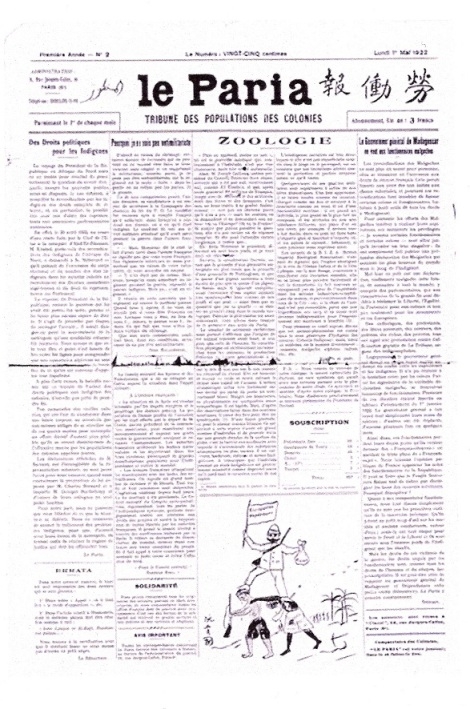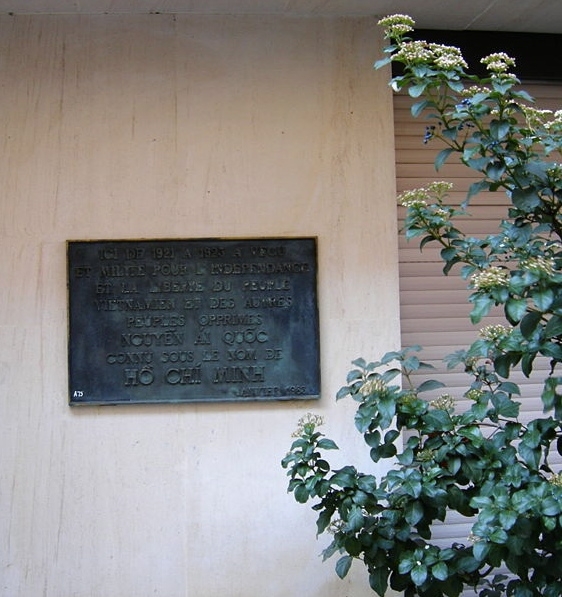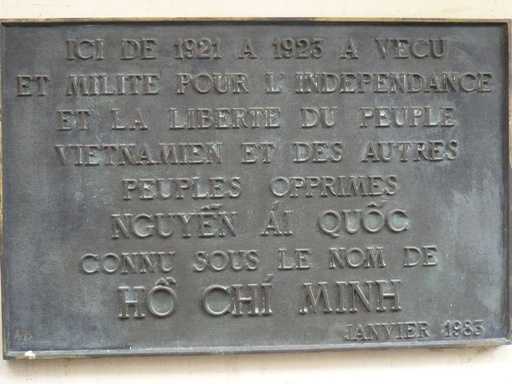>>Part 1: Paris, my two worlds
>>Part 2: A journey in search of freedom
>>Part 3: Nguyen the Patriot
>>Part 4: Indochina and little emperors
>>Part 5: The rise of patriotism
In part 6 of a series about Ho Chi Minh, Laura Lam addresses how from early on, Ho Chi Minh aspired for Vietnam to be independent.
 |
| Le Paria (title also in Arabic and Chinese) |
 |
| Impasse Compoint today, with bookstore of Resistance Movement. |
 |
| #9 Impasse Compoint, where Quoc lived. |
The great Peace Conference in Versailles was held in June 1919. Nguyen Ai Quoc delivered copies of his petition for independence to delegations of the United States and other major powers. A senior staff of President Wilson acknowledged it and thanked him in writing. But he never heard back from the US delegation.
Quoc also sent the petition to the President of France and key members of the National Assembly. The President wrote to Albert Sarraut, Governor-General of Indochina who had just returned to Paris, asking him to look into the matter, and to check the identity of the petition’s author.
Some members of the Assembly voiced their objection concerning France’s presence in Indochina and their opinion was debated. But the Colonialists had the final say. Meanwhile, news about Quoc’s petition spread quickly and stirred up patriotism among Vietnamese youths in France and in Indochina with dramatic effects. He became a public figure for the cause of Viet Nam’s struggle for independence.
With financial contributions from his friends in the French Socialist Party (FSP) and fellow Vietnamese, Quoc printed many thousand copies of the petition for circulation in the streets of Paris and in Indochina. For the Vietnamese, it was converted into a song so they could remember the “eight demands” by heart.
By this time Quoc had already found the support of several prominent politicians and writers in the FSP, including Marcel Cachin, Léon Blum, Paul Vaillant Couturier, Gaston Monmousseau, Jacques Doriot, Paul Louis, and Henri Barbusse. Quoc also became a close friend of Karl Marx’s grandson Jean Longuet, a lawyer and chief-editor of the journal Le Populaire. Both Longuet and Monmousseau would help Quoc polish his writing skill for publication and introduce him to editors in Paris.
Quoc’s petition was published in L’Humanité. And he began writing for several socialist journals in Paris. In early 1920, Quoc created his own monthly journal, Le Paria (The Outcasts). Inspired and enthusiastic writers in Asian and African colonies sent him regular contributions of articles. The paper had to be smuggled into the colonies. Le Paria soon became well known and also a major voice for the oppressed working class in France. In the colonies, anyone who read Le Paria would be subjected to arrest and detention.
At the Second Congress of the Communist International (Comintern) held in Moscow in August 1920, all Communist parties in Europe were instructed to establish colonial commissions. The goal was to unite the oppressed peoples in Asia and Africa and to support their fight for national independence. In early 1921, Quoc and members of the newly established French Communist Party (FCP) started meeting in Fontainebleau (south west of Paris) and the Colonial Study Commission was set up by summer.
With assistance from the new FCP, Quoc obtained a work visa and a carte de séjour (residence card). He found employment at a photo shop on “Impasse Compoint” in Batignolles, a very poor area north of Paris. Paul Vaillant Couturier helped him find an apartment next to the photo shop. Couturier was a congressman, as well as a gifted poet, journalist, and orator. He had been drafted into the army in 1914 and the horrors of war had turned him towards pacifism and communism. The two would become trusted friends.
A bookstore specializing in the literature of the Resistance Movement is now located at the beginning of Impasse Compoint. The area has been much improved in recent years. Quoc used to live at building #9, on the left side of the cul-de-sac. His studio was on the second floor, with a tiny window. There was no heating system. One of Quoc’s few possessions was a piece of red brick. During winter, each morning he would take the brick to his landlady, leaving it in her fireplace. In the evening, when he came home, he would collect the hot brick to warm his bed.
Friends enjoyed Quoc’s company and would visit his humble place. In the intimate setting, he would serve them a light meal with crispy stir-fry fresh vegetables or chunky vegetables sour soup (canh chua), accompanied by fluffy steamed rice. Some fresh fruits and jasmine tea would follow. His guests included the renowned short story writer Colette and the popular singer Maurice Chevalier. Quoc impressed his friends and acquaintances with his knowledge and determination, and many were captivated by his charm and fierce brilliance.

Plaque right below Quoc’s apartment.
In Vietnamese and English translation:
- "Tại nơi đây, từ 1921 đến 1923, Nguyễn Ái Quốc, người thường được biết tới với tên Hồ Chí Minh, đã sống và chiến đấu vì quyền độc lập và tự do cho nhân dân Việt Nam và các dân tộc khác bị áp bức."
- “At this place, from 1921 to 1923, Nguyen Ai Quoc, commonly known as Ho Chi Minh, had lived and fought for the freedom and independence of Viet Nam and other oppressed nations.”
